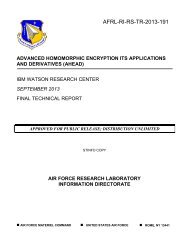EN100-web
EN100-web
EN100-web
You also want an ePaper? Increase the reach of your titles
YUMPU automatically turns print PDFs into web optimized ePapers that Google loves.
Special Theme: Scientific Data Sharing and Re-use<br />
be substantially different depending on<br />
whether:<br />
• outliers have been removed<br />
• missing values have been replaced by<br />
estimations<br />
• nominal values have been replaced<br />
by numerical values<br />
• some columns/rows have been deleted.<br />
A lot of uncertainty remains, related to<br />
this preprocessing step, because the<br />
modifications are not necessarily mentioned,<br />
especially in scientific publications<br />
about data analysis.<br />
In order to improve the transparency<br />
regarding the preprocessing phase, we<br />
have developed a JAVA standalone tool<br />
that allows the data to be transformed<br />
while keeping traces of the transformations.<br />
The tool is developed on top of the<br />
WEKA library, and allows the following<br />
preprocessing operations:<br />
column/row deletion, discretization of<br />
the numerical features, feature selection,<br />
constant feature deletion, missing values<br />
imputation, outlier deletion, attribute<br />
transformation (numerical fields to<br />
nominal fields, nominal fields to binary<br />
fields, etc.).<br />
The main features of the tool include:<br />
• The tool facilitates interactive data<br />
transformation: in fact, the user interface<br />
provides an exploratory process<br />
to successively apply transformation<br />
operations, and then check the results<br />
using visual views, such as tables,<br />
trees, heat maps, 2D projections, etc.<br />
During this process, the user can consult<br />
the history of the applied transformations<br />
and can cancel them as<br />
required.<br />
• After each data transformation, it is<br />
critical to gauge the intensity of data<br />
transformation (for example, the discretization<br />
of numerical values<br />
implies information loss) [2]. To this<br />
end, the tool instantly computes the<br />
ratio of values that are kept<br />
unchanged during the preprocessing<br />
steps [3]. This indicator is continuously<br />
shown in the user interface of<br />
the tool (Figure 1): 100% represents a<br />
slight transformation, 0% represents<br />
a considerable transformation.<br />
• The tool provides support to generate<br />
a consistent sequence of data processing:<br />
for example, if a data analyst<br />
wants to normalize these data, the<br />
tool will show him that outliers and<br />
extreme values should be removed.<br />
• In addition, the tool is able to automatically<br />
transform the data for a<br />
specific task: as an example, an algorithm<br />
has been developed in order to<br />
obtain transformed data that lead to<br />
simple prediction models [3].<br />
The tool can be applied in several use<br />
cases to improve the scientific<br />
reusability of data. Firstly, it helps to<br />
write reusable scientific papers by providing<br />
a full description of the preprocessing<br />
steps that have been applied on<br />
this dataset; moreover, it will help to<br />
avoid the ‘cherry picking issue’, that<br />
biases the results of a lot of data<br />
analysis papers. Secondly, it helps data<br />
scientists to inject data assumptions into<br />
real datasets (some techniques need<br />
data without missing values, others<br />
need data with numerical values only,<br />
etc.). More precisely, it allows the transparent<br />
construction of synthetic datasets<br />
from well-known data (such as the<br />
datasets from the UCI Repository) that<br />
finally can be used in experiments. As<br />
the transformation steps and the information<br />
loss indicator are explicitly<br />
shown by the tool, they can be<br />
described in the further technical/academic<br />
papers: it will improve the reproducibility<br />
for the article’s readers.<br />
A pending issue is to deal with data for<br />
which the original source is known but<br />
the preprocessing pipeline is unknown<br />
due to a lack of documentation. As a<br />
future work, we plan to create a reengineering<br />
method in order to automatically<br />
determine the preprocessing operations<br />
that have been applied, given an original<br />
dataset and its transformed version.<br />
Links:<br />
http://archive.ics.uci.edu/ml/<br />
http://www.cs.waikato.ac.nz/ml/weka/<br />
References:<br />
[1] Fazel Famili et al.: “Data<br />
preprocessing and intelligent data<br />
analysis”, International Journal on<br />
Intelligent Data Analysis, Volume 1,<br />
Issues 1–4, 1997.<br />
[2] Shouhong Wang, Wang Hai:<br />
“Mining Data Quality In Completeness”,<br />
ICIQ 2007, pp. 295-300.<br />
[3] Olivier Parisot et al.: “Data<br />
Wrangling: A Decisive Step for<br />
Compact Regression Trees”, CDVE<br />
2014, pp. 60-63.<br />
Figure 1: Preprocessing of the ‘vehicle’ dataset from the UCI repository: the data are<br />
represented using a PCA projection, the progress bar shows the data completeness and the<br />
applied operations are detailed on the bottom left of the window.<br />
Please contact:<br />
Olivier Parisot, Thomas Tamisier<br />
Public Research Centre – Gabriel<br />
Lippmann, Belvaux, Luxembourg<br />
E-mail: parisot@lippmann.lu,<br />
tamisier@lippmann.lu<br />
34<br />
ERCIM NEWS 100 January 2015



